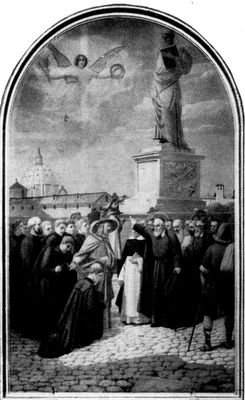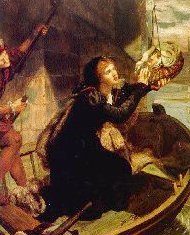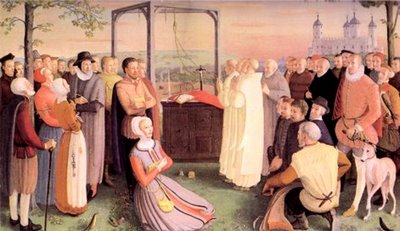Feast of St PHILIP NERI

Salvete Flores Martyrum- All Hail Ye Infant Martyr Flowers. St Philip Neri greets in the street the students of the English College in Rome with this phrase.

ENGLISH-SCOTTISH- WELSH- IRISH MARTYRS Between 1535 and 1681, over 600 Catholics died for the Catholic Faith and for the primacy of the Roman Pontiff, 54 were beatified in 1888 and nine more in 1895; 247 others had their cause of beatification introduced in 1886, being declared Venerable; the remainder (about 286), though they all died heroically, led more obscure lives. 40 were canonised in 1970.


Posted by
Catholic Conclave
at
2:33 PM
0
comments
![]()
Labels: english college, Philip Neri

Posted by
Catholic Conclave
at
2:00 AM
0
comments
![]()
Labels: John Fisher, saint, Thomas More
 Margaret Roper, his daughter, rescues St Thomas More's head after his execution.
Margaret Roper, his daughter, rescues St Thomas More's head after his execution.
Posted by
Catholic Conclave
at
2:17 PM
0
comments
![]()
Labels: saint, Thomas More

Posted by
Catholic Conclave
at
12:00 AM
0
comments
![]()
Labels: David Lewis, Forty Martyrs, John Jones, John Lloyd, John Roberts, Philip Evans, Richard Gwyn, Wales
comes to pray at the tomb of Blessed Dominic Barberi where he was then buried at Aston Hall. Dominic himself predicted that there would be priests forever in residence at Aston. He cannot have expected the present use.
ASTON HALL
by V. REV. CANON ARTHUR G. WALL
Aston Hall is situated in Aston, a village two miles south of Stone and about six miles north of Stafford.
The Hall contains bed-sitting rooms for eight priests who dine in community or in their own rooms if indisposed. There is an automatic lift to the bed-sitting rooms.
The Hall was purchased from Major Wenger in 1961 by Cyril Hartley, K.S.G., who gave it to the Birmingham Archdiocese as a guest house for retired and convalescent priests. Also, priests are welcome who wish to spend a little time and quietness in pleasant country surroundings. The Hall has a large garden, spacious grounds, and a field, altogether about six acres.
The Hall is served by a community of Sisters of Charity of St. Paul, whose head convent is at Selly Park, Birmingham. The Sisters are trained to serve the old and sick.
There is a very charming chapel in the Hall, near the main entrance, which is part of the Passionist Church erected by Blessed Dominic Barberi C.P.
The Hall is partly surrounded by a wide and deep moat (now dry). This gives some indication of the life of Aston Hall.
One of the glories of Aston is that with a few exceptions in recent times, it was always the home of good Catholic families. Old families like the Stanleys, Heveneninghams, Simeons and Welds were possessors. Early in the 19th Century there was a community of Franciscans, followed by Brigittine Nuns.
Father Benjamin Hulme was in charge of the Aston parish and lived in the Hall 1838-1842. Shortly after his arrival he was cleaning the Chapel when under the altar he found the lost relics of St. Chad. These relics are now the glory of St. Chads Cathedral, Birmingham.
In 1842 Father Dominic Barberi C.P. came to the Hall, and lived there until his death in 1849. The Passionist Fathers stayed on for some years and finally went to Sutton, near Preston, taking with them the body of Blessed Dominic.
After the departure of the Passionists the Aston parish was served by seculars. Father Huddleston (later Canon) was appointed Parish priest. He pulled down the old Hall and built the present one, finishing it in 1855. Canon Huddleston died in 1871. In 1909 the Hall was sold to non-Catholics and remained in non-Catholic hands until Major Wenger bought it.
Now it is a delightful home for retired and convalescent priests.
Many people have in recent years visited the Hall. Pilgrims come to see the hallowed spot where Blessed Dominic lived. Parish parties, desiring to see again their old Parish priest, come and are always welcome.
Priests and sick living in the Hall appreciate the good care and kindnesses of the Sisters in charge and find a great joy in living in a place hallowed by our grand old Catholic forefathers who kept the faith for us.
Posted by
Catholic Conclave
at
2:12 AM
0
comments
![]()
Labels: 1854, Blessed, Cardinal Newman, Dominic Barberi, Venerable
In the persons, places and dates section, the posts are categorised according to name, religious order, date of martydom, place of birth, place of death and other key associations such as the Northern Rising.
Keep scrolling down!
Previously posted material is also being updated. There are a few problems with the titles of earlier posts, which will be corrected soon.
Contact me catholicconclave@gmail.com with comments, information and even corrections if necessary.